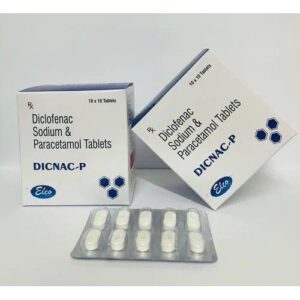PARACETAMOL + DICLOFENAC SODIUM
Paracetamol: Paracetamol, also known as acetaminophen, is a widely used medication for reducing pain and fever. It belongs to the class of drugs known as analgesics and antipyretics.
Paracetamol is commonly used for the relief of mild to moderate pain, including headaches, toothaches, muscle aches, and menstrual cramps. It is also effective in reducing fever. Unlike non-steroidal anti-inflammatory drugs (NSAIDs), such as ibuprofen or aspirin, paracetamol does not have significant anti-inflammatory effects.
The exact mechanism of action of paracetamol is not fully understood. It is believed to work primarily by inhibiting the synthesis of prostaglandins, which are chemicals involved in pain and fever regulation. By acting on the central nervous system, paracetamol helps to reduce the perception of pain and fever.
The usual dose of paracetamol for adults is 500 mg to 1000 mg every 4 to 6 hours, up to a maximum of 4 grams per day. The dose may vary depending on the severity of pain or fever. It is important to follow the recommended dosage instructions and not exceed the maximum daily limit to avoid potential liver damage.
Paracetamol is generally well-tolerated when used at recommended doses. However, like any medication, it can have side effects. The most common side effects include nausea, abdominal pain, and a rash. Rarely, it can cause serious adverse reactions, such as allergic reactions, liver damage, and blood disorders. People with liver disease, alcoholism, or taking certain medications should exercise caution and consult their healthcare provider before using paracetamol.
It is essential to read and follow the label instructions and consult a healthcare professional if symptoms persist or worsen. Paracetamol should not be taken along with other medications containing the same active ingredient, as this can lead to overdose and liver damage.
Diclofenac Sodium: Diclofenac Sodium is a nonsteroidal anti-inflammatory drug (NSAID) that is commonly used to relieve pain and reduce inflammation in conditions such as arthritis, menstrual cramps, and various acute injuries. It is available in both oral tablet form and as a topical gel or patch.
The mechanism of action of diclofenac sodium involves inhibiting the production of prostaglandins, which are chemicals that cause pain and inflammation in the body. By reducing the levels of prostaglandins, diclofenac sodium helps to alleviate pain and swelling.
The dose of diclofenac sodium varies depending on the condition being treated and the formulation used. For oral tablets, the usual starting dose for adults is 50 mg two to three times per day. However, your doctor may adjust the dose based on your individual needs. Topical formulations have specific instructions for application and should be followed accordingly.
Like all medications, diclofenac sodium has potential side effects. Common side effects include stomach upset, heartburn, nausea, diarrhea, and headache. Less commonly, it can cause more serious side effects such as ulcers, bleeding, liver problems, and allergic reactions. Long-term use or high doses of diclofenac sodium may increase the risk of cardiovascular events such as heart attack or stroke.
It is important to follow the prescribed dose and duration of treatment recommended by your healthcare provider. Always talk to your doctor or pharmacist about any existing medical conditions, allergies, or medications you are taking before starting diclofenac sodium to avoid potential drug interactions or complications.
Note: This answer is solely for informational purposes and should not be taken as medical advice. Always consult with a healthcare professional for specific guidance and recommendations regarding your unique circumstances.

